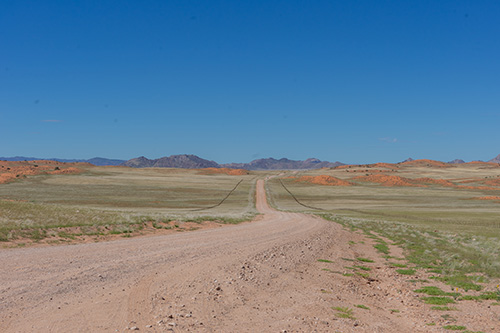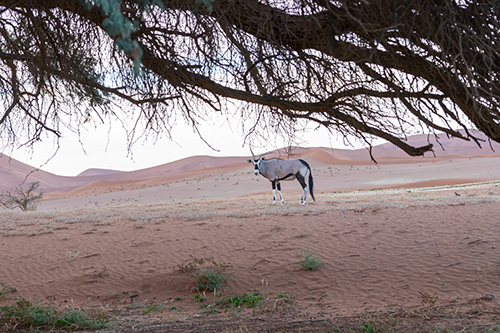Notes From Namibia | Global Social Work with Nicole Bromfield
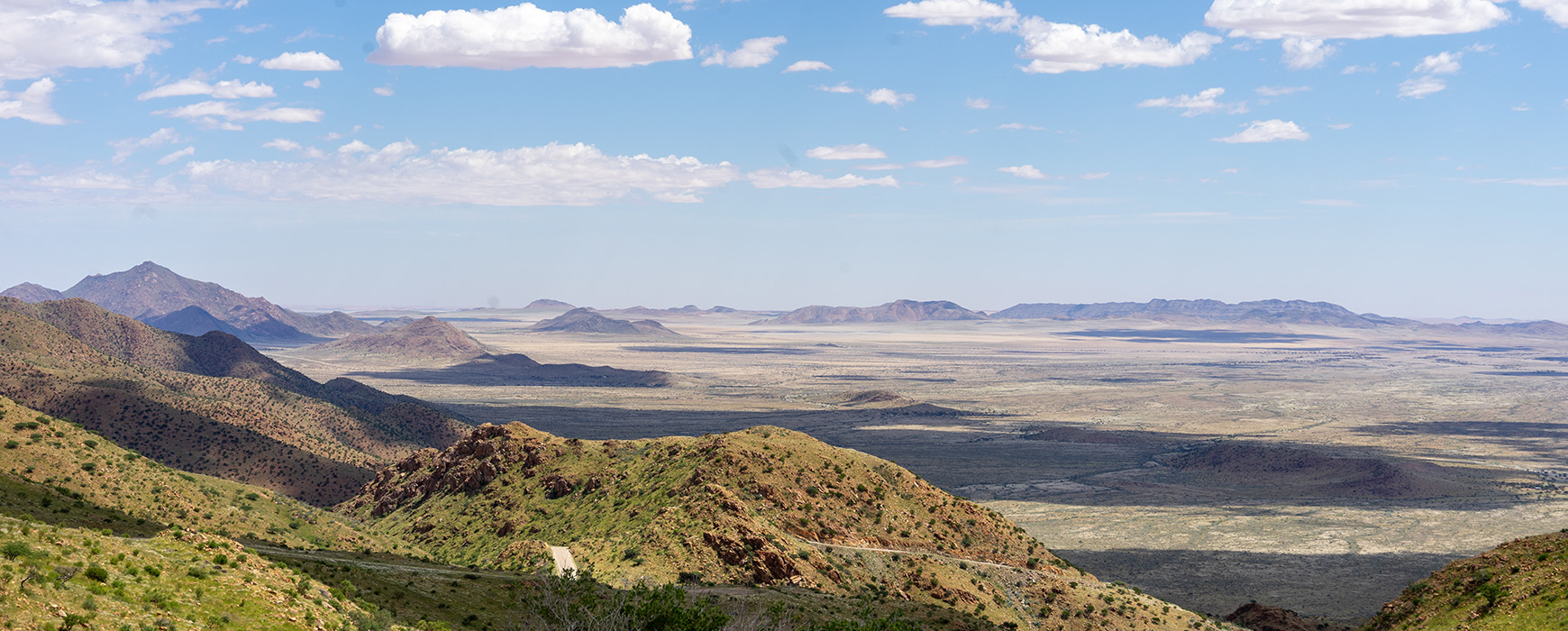

In this ongoing series, GCSW Associate Professor Nicole Bromfield will document her experiences and share her work as a 2022 Fulbright Research and Teaching Scholar at the University of Namibia.
May 2022 | Namibia and Gender Equality
After meeting with Dr. Veronica Theron last month, I thought it would be interesting
to discuss gender equality and gender issues in Namibia for the second segment of
my Notes from Namibia bi-monthly series. Dr. Theron is the Gender and Child Specialist
and Technical Advisor for the First Lady's (Madam Monica Geingos) Office of the Republic
of Namibia and also happens to be a Ph.D. level social worker.
With her team at the First Lady's Office, Dr. Theron has engaged in various unique
and innovative initiatives, including an anti-violence and anti-rape campaign featuring
survivors' stories. The Office has also raised awareness of violence through the #BreakFree
campaign and continues to work with and support youth on empowerment.
Reflecting on the Office's programs and initiatives led me to think more broadly about
gender equality efforts in Namibia, the ongoing challenges it faces, and what is required
to generate true gender equality.
Gender Equality Efforts in Namibia
Namibia has become a leader in gender equality efforts in Sub-Saharan Africa, with women's representation in Parliament reaching nearly 40%, government-mandated gender affirmative action, gender empowerment programs, and employment equity programs sponsored by the government. One of the early commitments of the South-West African People's Organization (SWAPO) party - who has controlled by the Namibian government since independence - was gender equality. During the liberation movement, a woman's arm of SWAPO worked alongside male leaders to fight for freedom from apartheid and South African control. After independence, SWAPO committed to filling half of its parliamentary seats with women via a quota system known as the zebra system. As per the zebra system, to promote more gender-equal politics, if, for example, a minister is a woman, the deputy minister must be a man and vice versa.That said, despite current government efforts, including the creation of the Ministry of Gender Equality, Poverty Eradication, and Social Welfare, Namibia still struggles with gender equality. According to my MSW students, although the zebra system, the Ministry of Gender Equality, and other government efforts to support gender equity tend to look good on paper, they haven't led to any real change regarding equality for women in Namibia.
Ongoing challenges
Namibia is complex, both in its history of colonialism and oppression and the tremendous
diversity among women in the country. Women are divided by race, tribe and ethnicity,
language, class, an immense rural-urban divide, education, political affiliation,
and so forth. Likewise, many of the women leading much of the gender equality efforts
and organizations are highly educated Black elite women living in Windhoek. As such,
some have argued publicly that these women leaders are unable to identify with the
poor, marginalized, rural, women who live in areas with no electricity or cell service
and limited educational opportunities.
My students have discussed and written about several ongoing issues in our policy
class that primarily impact women in Namibia. Some of these issues include:
Child Marriage: Currently, child marriage rates for girls in Namibia are over 18%, compared with 4% for boys. That said, some regions even experience child marriage rates as high as 40% for girls. Child marriage is particularly dangerous for girls as it can lead to early pregnancy and its resulting complications. Girls are also more likely to be prevented from accessing further education if they marry early, with many dropping out of school.
Abortion rights: In Namibia, women are prevented from accessing abortion, except in cases of rape, incest, or when the pregnancy poses a threat to the life of the mother or baby. This prohibition means there is an estimated 7,000 unsafe "back alley" illegal abortions each year, exposing women to the risk of severe complications or death.
HIV and AIDS: The rate of new HIV infections for adolescent girls and women is more than double for men in Namibia. The population of the Zambezi region, for example, experiences an HIV-positive rate of over 20% of the population overall.
Sexual and Gender-Based Violence (SGBV): Namibia struggles with SGBV, especially in the form of intimate partner violence, rape, and femicide. Some perceive intimate partner violence against women as a socio-cultural norm and a form of punishment, with significant acceptance, by both men and women. Rape also often goes unprosecuted due to the survivor's family having the option of settling out of court with the perpetrator's family. Usually, this presents itself in the form of a lump-sum payment to the survivor's family.
Despite the challenges noted above, Namibia is leading the way when compared with other nations on the African continent in their effort to reach gender equality.
Travels through Damaraland
During a recent long holiday weekend, my family and I traveled through Damaraland, a rural and desolate area of rugged, barren landscape, where wild desert-adapted elephants and lions roam free. It is home to the Damara people and others, and while there, with the permission and consent of those I encountered, I snapped a few shots of women at work; I also received consent to share the photos in this article.
The pictures I took captured images of women in Namibia working in various capacities, including as government workers, museum clerks, or self-employed women selling handmade jewelry and carvings. All of them wear some form of traditional dress, which, according to my colleagues, represents both pride and rebellion against the former colonialists, who sought to force them to adopt more western-style clothing to cover their bodies.
In these photos, I see these women's unique power, strength, and pride - something I have witnessed each time I have had the pleasure of connecting with women here in Namibia. I believe that this power has a huge part to play in the country's unified efforts to truly realize gender equality. True transformation requires efforts beyond representation in leadership positions; it involves recognizing, respecting and legitimizing female bodily autonomy, improving access to health, education and employment, and finding new and tangible ways to empower women, both rural and urban and from all ethnic groups.
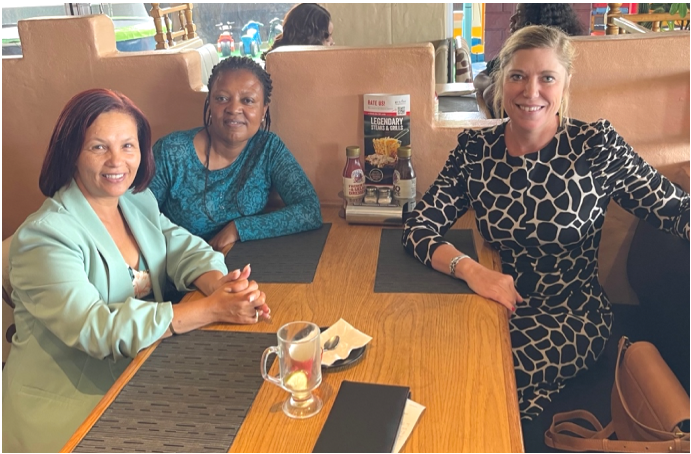
Meeting with Dr. Veronica Theron (in green jacket) and Dr. Ananais (UNAM Professor), to learn more about Dr. Theron’s initiatives as an advisor to the First Lady’s Office and the Child and Gender Specialist for Namibia.
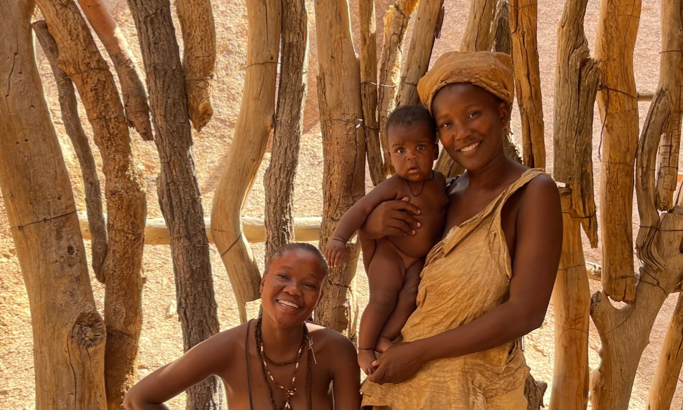
!Gaidi and Moeter. They are Damara women and work as clerks at the Damara Living Museum.
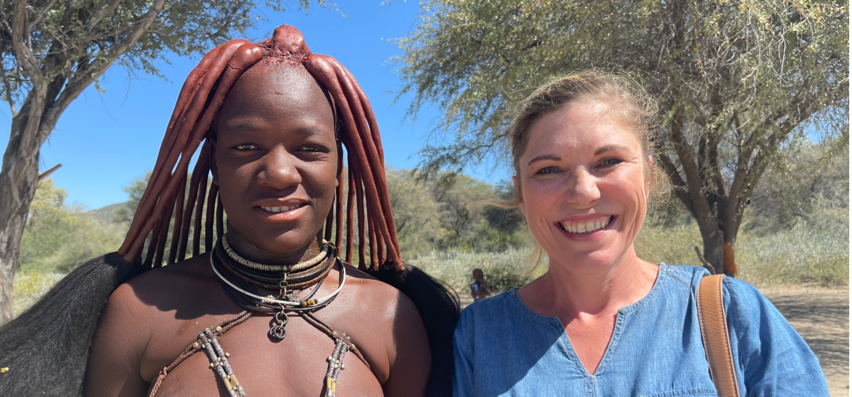
Kandambo is a Himba woman and sells her homemade jewelry made by her
and carvings made by her husband at a roadside stall.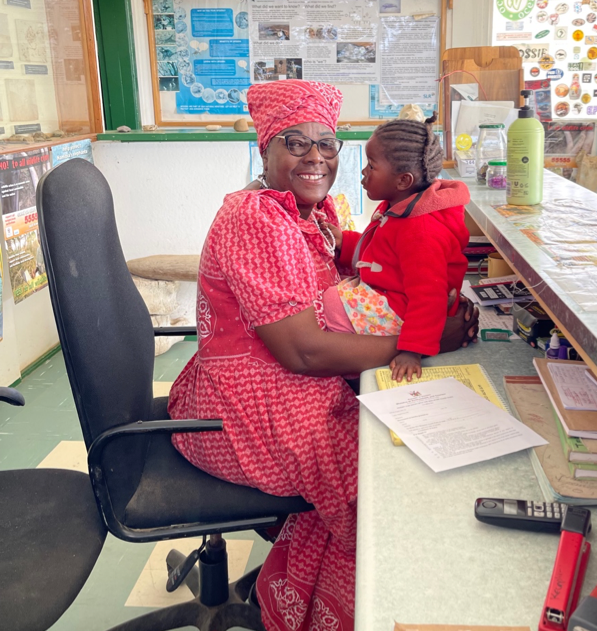
Hilga works at a check-point to a national park.
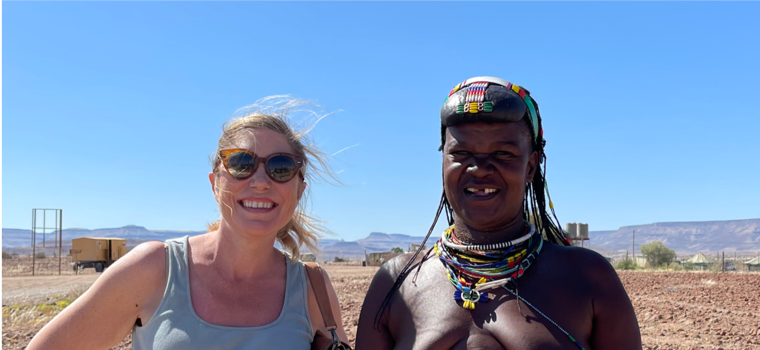
Nahipe is Zemba and sells her homemade jewelry next to a gas station in a remote area.
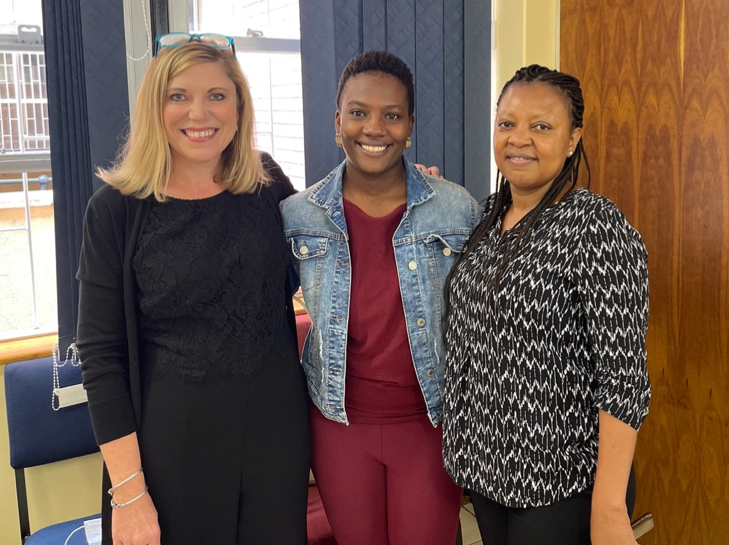
Faculty at UNAM in the Department of Psychology and Social Work: Annelisa Murangi
and Janet Ananais.
March 2022 | A Brief History of Namibia for American Social Workers
Namibia is one of the most fascinating places that I have ever been. The landscape is incredibly stunning and diverse. My husband, Mark, and I constantly say to each other as we drive down the road, “wow, look at that!” or “did you see that?; we have to stop and take a photo!” I can say without hesitation that it is the most striking country that I have ever had the pleasure to travel in. Within a few hours distance, one can see majestic mountains, sand dune deserts, and spectacular wildlife drinking from a waterhole in the Kalahari desert. The big five safari animals (African elephant, lion, leopard, African buffalo, and rhinoceros) are abundant, and Namibia has the largest wild cheetah population in the world. It is also one of the least densely populated countries globally, with 2.5 million people.
As with the landscape and wildlife, the country's history is also fascinating yet tragic at the same time. As we know, as social workers, one must understand the historical and local cultural context to teach or practice social work at any level. So in this first Note from Namibia, I will provide some historical context of the country with that in mind.
Namibia’s rich history extends all the way back to the evolution of early human beings; more recent research has suggested that Namibia is part of the “cradle of humankind,” so we are all Namibians. Unfortunately, the beauty and richness of Namibia have come at a steep price for the indigenous people and the later inhabitants from other African nations. A land rich in valuable resources, notably marine diamond deposits, the area known today as Namibia was ostensibly left open for stealing and looting by European conquests and settlers.
Some of Namibia’s pre-colonial history has not been well documented. Still, extensive archaeological evidence and early cave paintings show that the land was first inhabited by hunter-gatherers and later traditional pastoralists and farmers, traders, miners, and fishers. The people belonged to various racial and cultural groups, with unique traditions, religions, and languages. The San People, who were hunter-gatherers, were the native inhabitants of Namibia, along with the later arrival of the Damara, Nama, Herero, Himba, Ovambos, Oorlams, Kavangos, East Caprivians, Rehoboth Basters, Kaokovelders, and Tswanas.
Similar to what occurred to indigenous populations in the United States and around the world, during the early 1800s, German missionaries from the London Missionary Society arrived with the apparent intention of converting locals to Christianity through the word of God, food, western clothing, western housing, and work. Ultimately this was part of their plan to claim the land as their own. The Germans invaded and occupied Namibia, thus creating what they called “German South West Africa.” Namibia subsequently was under foreign colonial rule from 1884 until 1990.
Namibia was not the only land being invaded at the time. The so-called “Scramble for Africa” saw many parts of Africa taken over by Western European powers. Unfortunately, the need for power also comes greed, the result being a hostile takeover and the tragic genocide of indigenous inhabitants of Namibia, namely the Herero and Nama peoples who lived in southern and central Namibia and joined forces to resist the brutal German colonial occupation. German forces massacred over half of Namibia's south and central populations during this time.
As history unfolded, Britain claimed authority in Southern Africa and ultimately wanted to take over Namibia. As a result, thousands of Black Namibians lost their lives or were condemned to slavery as the battles for occupancy between British and German forces ensued.
British and South African forces entered Namibia during the First World War, and war began against the German colonists. The British predominantly sided with the indigenous peoples and ultimately drove German forces from the land. Unfortunately, this put Namibia under the control of South Africa and under brutal Apartheid rule, which was likely no better than being under German colonial rule. Thus, white minority rule continued in Namibia under South African control.
Apartheid prevented Black Namibians from having political rights and restricted their freedom and movement. They were severely oppressed, exploited, and largely forced into settlements in the North. People were also segregated by ethnic groups to specific “homelands.” Schools, hospitals, social service agencies, and other governmental services were segregated for black or white populations until 1990; the services for Black Namibians were woefully inadequate and underfunded, while the white Namibian population enjoyed the highest level of services.
In 1966, the South West African People’s Organization (SWAPO) began a liberation war against South Africa. SWAPO had been founded earlier, and the organization had its roots among the Ovambo people of northern Namibia, who make up almost half the population. Black Namibians fought for their liberation for 22 years against South Africa to finally gain independence. Namibia was granted its independence in 1990, led by Sam Nujoma, the SWAPO leader who became the first President of Namibia.
The President, currently Hage Geingob, is both the Head of State and Head of Government in a multi-party system. The President exercises executive power while legislative power falls in the hands of two chambers of Parliament, while there is also an independent judiciary power. Along with this governmental political structure, Namibia is also managed by traditional leadership, with 51 recognized traditional authorities and leaders. Traditional leaders are responsible for allocating communal land and the traditional group's customary laws.
Today, white Namibians make up 6% of the population yet own 70% of the land, though a land resettlement program is ostensibly redistributing land to the poorest Namibians. Unfortunately, land resettlement has fallen into corruption, with those in the Black political and bureaucratic elite receiving preferential treatment in land redistribution. At the same time, those from the most marginalized and poorest ethnic groups remain landless.
Thus the dark shadow of foreign colonial rule and apartheid endures, and land ownership is one of the starkest reminders of its legacy. Namibia is one of the most unequal countries globally, and the COVID-19 Pandemic has exacerbated this inequality. Sixty-five percent of the population is poor at a USD 5.50 per person per day poverty line, according to the World Bank, and 43% of Namibians experience multidimensional poverty. As with the rest of the world, the Global Pandemic has had the most significant impact on the most vulnerable.
Poverty is just one of the examples of the inequities that still exist. White Namibians hold over 80% of the wealth in the country. However, a growing Black middle-class is growing, and Black Namibians have controlled the government since independence. Based on my conversations with people, there are many open wounds and traumas and many more festering under the surface that have not yet openly been discussed in the public sphere. There are also more recent class tensions and tensions between various ethnic groups in the country. From my perspective as a white outsider, the resentment between white and Black Namibians is palpable.
This is a brief excerpt of the history of Namibia to put a bit of context to current social work education and practice. This semester I am teaching Social Policy Analysis at the master’s level. The students in my course are professional social workers (all with BSWs) from all over the country from different backgrounds, and all are Black Namibians, except one student. The students work in private practice, corrections, public hospitals, and government social service agencies. Classes here only started a few weeks ago; I have already learned so much from them. I am grateful to be here and grateful to be working with Namibian social workers in my capacity as a professor. I hope to do the course justice for them and the University of Namibia, where I teach as a Fulbright Scholar.
Nicole F. Bromfield, PhD, MSW
Associate Professor, GCSW
Fulbright Research and Teaching Scholar
University of Namibia 2022
